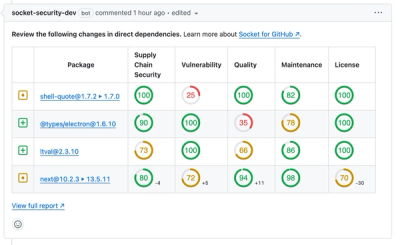
Security Fundamentals
Turtles, Clams, and Cyber Threat Actors: Shell Usage
The Socket Threat Research Team uncovers how threat actors weaponize shell techniques across npm, PyPI, and Go ecosystems to maintain persistence and exfiltrate data.
当前最新版本: 0.6.14
Juicer 是一个高效、轻量的前端 (Javascript) 模板引擎,使用 Juicer 可以是你的代码实现数据和视图模型的分离(MVC)。除此之外,它还可以在 Node.js 环境中运行。
你可以在遵守 MIT Licence 的前提下随意使用并分发它。Juicer 代码完全开源并托管在 Github 上,如果你在使用的过程中发现什么 Bug 抑或是一些好的建议都欢迎在 Github Issue 上提交。
倘若我们把数据比作新鲜可口的水果,把模板看做是水,Juicer 就是把水果和水榨出我们需要的HTML代码片段的榨汁机。
<script type="text/javascript" src="juicer-min.js></script>
> 编译模板并根据所给的数据立即渲染出结果.
juicer(tpl, data);
> 仅编译模版暂不渲染,它会返回一个可重用的编译后的函数.
var compiled_tpl = juicer(tpl);
> 根据给定的数据,对之前编译好的模板进行数据渲染.
var compiled_tpl = juicer(tpl);
var html = compiled_tpl.render(data);
> 注册/注销自定义函数(对象),在下边 ${变量} 中会有实例.
juicer.register('function_name', function);
juicer.unregister('function_name');
> 自定义模板语法边界符,下边是 Juicer 默认的边界符。你可以借此解决 Juicer 模板语法同某些后端语言模板语法冲突的情况.
juicer.set({
'tag::operationOpen': '{@',
'tag::operationClose': '}',
'tag::interpolateOpen': '${',
'tag::interpolateClose': '}',
'tag::noneencodeOpen': '$${',
'tag::noneencodeClose': '}',
'tag::commentOpen': '{#',
'tag::commentClose': '}'
});
{
cache: true [false],
strip: true [false],
errorhandling: true [false],
detection: true [false]
}
默认配置是 Juicer 推荐的使用方式,如果你使用过程中的确需要更改这些参数,可以这么做:
juicer.set('strip',false);
juicer.set('cache',false);
juicer.set({
'strip': false,
'cache': false
};
Juicer 默认会对编译后的模板进行缓存,从而避免同一模板多次数据渲染时候重复编译所耗的时间,如无特殊需要,强烈不建议关闭默认参数中的 cache,这么做将会令 Juicer 缓存失效从而降低性能.
使用 ${} 输出变量值,其中_为对数据源的引用(如${_},常用于数据源为数组的情况)。支持自定义函数(通过自定义函数你可以实现很多有趣的功能,类似 ${data|links} 就可以通过事先定义的自定义函数 links 直接对 data 拼装出<a href=".." alt=".." /> ).
${name}
${name|function}
${name|function, arg1, arg2}
让我们通过一个例子演示一下自定义函数的奇妙用法吧.
var json = {
links: [
{href: 'http://juicer.name', alt: 'Juicer'},
{href: 'http://benben.cc', alt: 'Benben'},
{href: 'http://ued.taobao.com', alt: 'Taobao UED'}
]
};
var tpl = [
'{@each links as item}',
'${item|links_build} <br />',
'{@/each}'
].join('');
var links = function(data) {
return '<a href="' + data.href + '" alt="' + data.alt + '" />';
};
juicer.register('links_build', links); //注册自定义函数 juicer(tpl, json);
上述代码执行后我们会发现结果是这样的:
<a href="http://juicer.name" alt="Juicer" <br />
<a href="http://benben.cc" alt="Benben" <br />
<a href="http://ued.taobao.com" alt="Taobao UED" <br />
可以看得出,结果被转义了,如果我们上边使用 $${item|links} 就会得到我们预期的结果,这就是下边即将提到的避免转义。
转义/避免转义
出于安全角度的考虑,${变量} 在输出之前会对其内容进行转义,如果你不想输出结果被转义,可以使用 $${变量} 来避免这种情况。例如:
var json = {
value: '<strong>juicer</strong>'
};
var escape_tpl='${value}';
var unescape_tpl='$${value}';
juicer(escape_tpl, json); //输出 '<strong>juicer</strong>'
juicer(unescape_tpl, json); //输出 '<strong>juicer</strong>'
如果你需要对数组进行循环遍历的操作,就可以像这样使用 each .
{@each list as item}
${item.prop}
{@/each}
如果遍历过程中想取得当前的索引值,也很方便.
{@each list as item, index}
${item.prop}
${index} //当前索引
{@/each}
我们也会经常碰到对数据进行逻辑判断的时候.
{@each list as item,index}
{@if index===3}
the index is 3, the value is ${item.prop}
{@else if index === 4}
the index is 4, the value is ${item.prop}
{@else}
the index is not 3, the value is ${item.prop}
{@/if}
{@/each}
为了后续代码的可维护性和可读性,我们可以在模板中增加注释.
{# 这里是注释内容}
辅助循环是 Juicer 为你精心设置的一个语法糖,也许你会在某种情境下需要它.
{@each i in range(5, 10)}
${i}; //输出 5;6;7;8;9;
{@/each}
子模板嵌套可以让你更灵活的组织你的模板代码,除了可以引入在数据中指定的子模板外,当然你也可以通过指定字符串#id使用写在script标签中的模板代码.
HTML代码:
<script type="text/juicer" id="subTpl">
I'm sub content, ${name}
</script>
Javascript 代码:
var tpl = 'Hi, {@include "#subTpl", subData}, End.';
juicer(tpl, {
subData: {
name: 'juicer'
}
});
//输出 Hi, I'm sub content, juicer, End.
//或者通过数据引入子模板,下述代码也将会有相同的渲染结果:
var tpl = 'Hi, {@include subTpl, subData}, End.';
juicer(tpl, {
subTpl: "I'm sub content, ${name}",
subData: {
name: 'juicer'
}
});
在命令行中执行:
npm install juicer
在代码中这么引入:
var juicer = require('juicer');
var html = juicer(tpl, data);
在 Express 2.x 系列版本中:
npm install juicer
var juicer = require('juicer');
app.set('view engine', 'html');
app.register('.html', {
compile: function(str, options) {
return juicer.compile(str, options).render;
}
});
在 Express 3.x 系列版本中:
npm install juicer
var juicer = require('juicer');
var fs = require('fs');
app.set('view engine', 'html');
app.engine('html', function(path, options, fn){
fs.readFile(path, 'utf8', function(err, str){
if (err) return fn(err);
str = juicer(str, options);
fn(null, str);
});
});
在 Express 4.x 系列版本中:
var juicerExpressAdapter = require('juicer-express-adapter');
app.set('view engine', 'html');
app.engine('html', juicerExpressAdapter);
在命令行预编译模板文件:
npm install -g juicer
juicer example.juicer.tmpl -f example.js
// type `juicer` after install for more help.
// 全局模式安装 `juicer` 后,在命令行下输入 `juicer` 可以获得更多帮助信息。
为模板引擎设置外部Cache存储:
var juicer = require('juicer');
var LRUCache = require('lru-native');
var cache = new LRUCache({ maxElements: 1000 });
juicer.set('cachestore', cache);
HTML 代码:
<script id="tpl" type="text/template">
<ul>
{@each list as it,index}
<li>${it.name} (index: ${index})</li>
{@/each}
{@each blah as it}
<li>
num: ${it.num} <br />
{@if it.num==3}
{@each it.inner as it2}
${it2.time} <br />
{@/each}
{@/if}
</li>
{@/each}
</ul>
</script>
Javascript 代码:
var data = {
list: [
{name:' guokai', show: true},
{name:' benben', show: false},
{name:' dierbaby', show: true}
],
blah: [
{num: 1},
{num: 2},
{num: 3, inner:[
{'time': '15:00'},
{'time': '16:00'},
{'time': '17:00'},
{'time': '18:00'}
]},
{num: 4}
]
};
var tpl = document.getElementById('tpl').innerHTML;
var html = juicer(tpl, data);
FAQs
a high-performance lightweight javascript template engine
The npm package juicer receives a total of 1,094 weekly downloads. As such, juicer popularity was classified as popular.
We found that juicer demonstrated a not healthy version release cadence and project activity because the last version was released a year ago. It has 2 open source maintainers collaborating on the project.
Did you know?

Socket for GitHub automatically highlights issues in each pull request and monitors the health of all your open source dependencies. Discover the contents of your packages and block harmful activity before you install or update your dependencies.

Security Fundamentals
The Socket Threat Research Team uncovers how threat actors weaponize shell techniques across npm, PyPI, and Go ecosystems to maintain persistence and exfiltrate data.

Security News
At VulnCon 2025, NIST scrapped its NVD consortium plans, admitted it can't keep up with CVEs, and outlined automation efforts amid a mounting backlog.

Product
We redesigned our GitHub PR comments to deliver clear, actionable security insights without adding noise to your workflow.